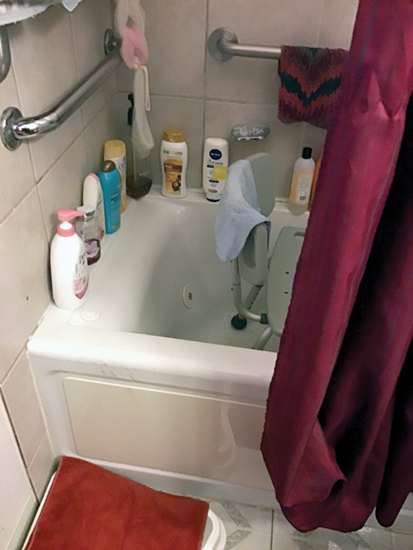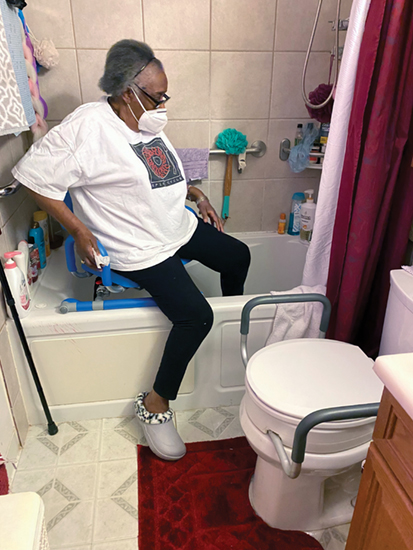Safe at Home: A community-based approach for home modification implementation
The Safe at Home (SAH) program is a grant-based home modification program aimed at reducing fall risk among community-dwelling older adults in Washington, DC. The program utilizes the skills of occupational therapy practitioners to provide recommendations for home modifications, then partners with contractors for installation. It is the hope that this type of program can be replicated so that individuals around the country will have access to similar services.
AOTA members get more. Join or sign in for access to this resource
The Safe at Home (SAH) program is a grant-based home modification program aimed at reducing fall risk among community-dwelling older adults in Washington, DC. The program utilizes the skills of occupational therapy practitioners to provide recommendations for home modifications, then partners with contractors for installation. It is the hope that this type of program can be replicated so that individuals around the country will have access to similar services.
Background
In 2010, 16.1% of DC residents aged 65+ reported they had experienced at least one fall in the last 3 months (Behavioral Risk Factor Surveillance System, 2010). SAH was created by DC-based advocates for senior programming and the DC Office on Aging (DCOA) to address the need for home modifications for community-dwelling older adults in Washington, DC. Simultaneously, the DC Council enacted the Safe at Home Act of 2015 (B21-0316) in support of the program. The goal of the program was to mitigate fall risk in the home and the associated costs of falls. Rather than just providing contractors to repair or install items in homes, OT practitioners were chosen to be an integral part of the program from its inception by the stakeholders that advocated for the program, based on their holistic approach and problem-solving skills.
OT practitioners are uniquely positioned to provide comprehensive client evaluations and develop client-centered recommendations for home modifications given their training in occupational and activity analysis, and recognizing the interrelated nature of the person, the environment, and occupations (American Occupational Therapy Association [AOTA], 2020). Consequently, SAH chose OT practitioners with advanced training in home modifications to pair with clients to make decisions related to their homes.
Program Research and Early Development
In 2011, the Falls Free Coalition, founded by the lead author, began advocating for a DC home modification program that would be accessible for consumers and would implement OT practitioner-recommended modifications. A home modification literature review indicated that programs that use OT practitioners to make home safety recommendations, supply a contractor, and assist in payment for those modifications have better outcomes, such as greater client adherence to home safety recommendations, reduction in falls, promotion of longevity within the home, and enhanced fit of home and individual (Chase et al., 2012; Currin et al., 2012; Gitlin et al., 2006; Gitlin et al., 2009; Leland et al., 2012; Pighills et al., 2011). The literature is also clear that OT practitioners should employ client-centered practices in the decision-making process. This client-focused approach helps to overcome barriers of cost and aesthetics leading to improved utilization of recommendations (Aplin et al., 2014).
Following approval from the DCOA and the Mayor’s Office in 2015, a pilot program was initiated. The SAH pilot initially allocated funding only for an OT evaluation, and did not have a way to help clients implement the recommendations. Clients expressed concern over their inability to fund the modifications, and this concern was brought to the attention of the DCOA. Recognizing the implications of leaving this need unmet, the city dedicated a more substantial budget to the program for installation of home modifications. The funding was granted to Home Care Partners, a local not-for-profit home health organization, to implement the program.
Current Operations
The program currently operates with a $6,000 budget per household to cover contractor installation of the OT practitioner-recommended items. To qualify for SAH, DC residents must be aged 60 or older or be older than 18 with a disability, and have an income of less than 80% of the area’s median income ($70,550 for a 1-person household in 2021). SAH works with both homeowners and renters, obtaining approval from landlords for any installation in rental units.
Clients are assessed by OT practitioners with specialty training and certification in home modification practices. This additional training allows for improved understanding of integrating home modifications effectively for a client and for increased consistency in the evaluation and recommendation process. The OT assessment begins with a review of medical history, functional status, and history of falls. The client then performs several evidence-based measures so the OT practitioner can assess mobility, cognition, vision, strength, and balance. The Falls Efficacy Scale (FES) (Tinetti et al., 1990), measuring a fear of falling, and the Safety Assessment of Function and The Environment for Rehabilitation in home version (SAFER HOME) (Chiu & Oliver, 2006) measuring safety barriers in the home, are also completed. The process concludes with a tour of the home to observe functional mobility in the space, determine recommendations for modifications, and take photographs to assist with installation specifications. After the assessment, the OT practitioner, client, and/or caregiver collectively develop prioritized recommendations for modifications and durable medical equipment (DME).
SAH adheres to a preset price list of specific items to standardize pricing and expectations for modifications and DME. Typical modifications include grab bars, stairlifts, railings, shower chairs, handheld showers, toilet risers, lighting, and ramps. DME and smaller items include assistive devices, power recliners, and nightlights. SAH does not complete larger scale home repairs, such as replacing doors, ceilings, or flooring.
The OT assessment is developed into a scope of work for the contractor, with communication occurring between contractors and the OT practitioner throughout the installation process. After installation is complete, the OT practitioner revisits the client’s house to assess occupational performance and safety, and to measure outcomes. OT practitioners also ensure all work was completed as specified, provide training for the client, and add any final modifications, if needed.


Before First Episode 1 & 2: The first time we met Ms. C., she had glass shower doors and a single horizontal grab bar at the rear of the tub.
Outcome Measures
Demographics are collected for each client, including household information, age, race, gender, and type of housing. See Figure 1.
|
Figure 1. Demographics |
|
|
Mean Age |
75.3 |
|
Identified Gender |
90% Female |
|
Household Members |
90% Live alone |
|
Identified Race |
97% African American |
|
Housing Type |
|
The OT practitioners perform the two outcome measures pre- and post-intervention: the FES and the SAFER HOME. The FES psychometric properties have a test-retest reliability of .96 in an older adult population and internal reliability of .96 (Tinetti et al., 1990). The SAFER HOME has a strong overall internal consistency coefficient of 0.86 and a range of .539 to .789 for the subscales (Chiu & Oliver, 2006).
SAH maintained internal data for FY 2017–2021 (4,457 jobs completed). Using pre- and post-scores from the FES and SAFER HOME, the noted decline in clients’ fear of falling and barriers present in the home can be calculated (see Table 1). A lower FES score indicates less fear of falling, and a lower SAFER HOME scores indicates fewer safety hazards.
|
Table 1. Outcomes (FES and SAFER HOME scores FY 17–FY21) |
|||
|
Pre-SAH intervention (Average score) |
Post-SAH intervention(Average score) |
% Decrease in scores |
|
|
FES |
41.6 |
20.9 |
50% |
|
SAFER HOME |
23.4 |
9.3 |
60% |
SAH also surveys clients for quality control components and satisfaction with the program (see Table 2). The table of results was shortened to provide only those responses pertaining to SAH outcomes. In FY 2019, 92% of clients surveyed expressed complete satisfaction.
|
Table 2. Post SAH Intervention Client Surveys for FY 2019* |
|||
|
Question |
Not at All Satisfied |
Adequately Satisfied |
Completely Satisfied |
|
Q3. Satisfaction with plans for modification |
1 |
31 |
322 |
|
Q4. Satisfaction with SAH ability to help me stay in my home |
3 |
29 |
324 |
|
Q5. Comfort moving around home after SAH |
2 |
28 |
327 |
|
Q10. Overall satisfaction with SAH services |
1 |
28 |
335 |
|
*Limited data for FY 2020 and 2021 due to decreased office staff during the COVID-19 pandemic. |
|||
Since its inception, SAH intervention has consistently resulted in lower scores on the FES and SAFER HOME and high satisfaction ratings. This may be due to several features integral to SAH, including a client-centered approach, OT practitioners with specialty certifications completing the client assessment and training, the covered costs of OT and contractor services, a $6,000 per household budget, and close partnerships with contractors.
Based on the consistency of outcomes across 4 fiscal years, the home modification expertise of the OT practitioners has been successful in developing consistent client-centered recommendations for home modifications. Research and experience gleaned from the pilot program illustrate the importance of the program covering the cost of installation of the modifications to ensure that residents can follow through with the recommendations. Further, the $6,000 budget has been vital to provide many of the modifications needed to safely age in place. This budget permits the OT practitioner to make recommendations for the entire home, rather than focusing on only one part of it. Lastly, SAH has a close partnership with each contractor, allowing for open communication regarding each client’s modifications.
Client survey data illustrate that SAH has assisted clients in both accepting modifications and maintaining aging in place. Overall, both the client data and evaluation outcomes demonstrate that SAH positively impacts Washington, DC, by diminishing fear of falls and removing barriers to occupational performance in the homes of clients served. Qualitative data is consistent with outcome measures including client reports post-intervention:
LW: “I can shower and bathe so much safer now. I love everything, but especially the bathroom. It is so safe for me now."
KC: “I could just come home after my surgery. I didn’t have to go to rehab or to a friend’s house.”
DM: Daughter reports the homeowner "wouldn't know what to do without the rails and bars after hospital discharge."

Before Final Episode: After picture of the first episode. We removed the glass doors and track, and installed a shower curtain, additional grab bars, a handheld shower, and a shower seat.

After Final Episode: After picture of the latest episode. We provided an edge mounted swivel seat because she was no longer able to step over the side of the tub. She also received an additional grab bar.
Future Goals
COVID-19 restrictions resulted in a ban on home visits from March 2020 through July 2020. During this time, the staff OT practitioners consulted with academic researchers to add data points for future outcome measures, including self-reported quality of health, assistance required with ADLs, formal caregiver hours, number and location of reported falls, and health care utilization costs due to falls pre- and post-intervention. Preliminary data suggest a decrease in reported falls, decrease in assistance required for ADLs, and increase in self-reported quality of health. However, more data need to be collected to perform a robust analysis of these new data points.
SAH has helped more than 4,400 households in Washington, DC, and envisions the continued provision of high-quality service to support residents of the city. Steps to continue to grow the program may include integrating more staff OT practitioners to increase efficiency. This would allow for further development and trial of innovative modifications and processes for SAH clients. SAH also hopes to align with a home repair program for large-scale repairs, such as mold, foundation cracks, and roof repair because clients may benefit from a streamlined application process for these services.
SAH has proven to be a successful program, the foundation of which is the OT practitioners with specialty training. It is the hope that this program can be reproduced in other geographic areas. SAH welcomes collaboration to bring this type of program to other communities.
References
American Occupational Therapy Association. (2020). Occupational therapy practice framework: Domain and process (4th ed.). American Journal of Occupational Therapy, 74(Suppl. 2), Article 7412410010. https://doi.org/10.5014/ajot.2020.74S2001
Aplin, T., De Jonge, D., & Gustafsson, L. (2014). Understanding home modifications’ impact on clients and their family’s experience of home: A qualitative study. Australian Occupational Therapy Journal, 1–8. https://doi.org/10.1111/1440-1630.12156
Behavioral Risk Factor Surveillance System. (2010). 2010 annual health report. DC Health.https://dchealth.dc.gov/sites/default/files/dc/sites/doh/publication/attachments/BRFSS_Annual_Report_2010.pdf
Chase, C., Mann, K., Wasek, S., & Arbesman, M. (2012). Systematic review of the effect of home modification and fall prevention programs on falls and the performance of community-dwelling older adults. American Journal of Occupational Therapy, 66, 284–290. https://doi.org/10.5014/ajot.2012.005017
Chiu, T., & Oliver., R. (2006). Factor analysis and construct validity of the SAFER-HOME. OTJR: Occupation, Participation and Health, 26(4), 132–142. https://doi.org/10.1177/153944920602600403
Currin, M., Comans, T., Heathcote, K., & Haines, T. (2012). Staying safe at home: Home environmental audit recommendations and uptake in an older population at high risk of falling. Australian Journal of Aging, 31(2), 90–95. https://doi.org/10.1111/j.1741-6612.2011.00545.x
Gitlin, L., Hauck, W., Dennis M., Winter, L., Hodgson, N., & Schinfeld, S. (2009). Long-term effect on mortality of a home intervention that reduces functional difficulties in older adults: Results from a randomized trial. Journal of the American Geriatrics Society, 57, 467–481. https://doi.org/10.1111/j.1532-5415.2008.02147.x
Gitlin, L. N., Winter, L., Dennis, M. P., Corcoran, M., Schinfeld, S., & Hauck, W. W. (2006). A randomized trial of a multicomponent home intervention to reduce functional difficulties in older adults. Journal of the American Geriatrics Society, 54, 809–816. https://doi.org/10.1111/j.1532-5415.2006.00703.x
Leland, N., Elliot, S., O’Malley, L., & Murphy, S. (2012). Occupational therapy in fall prevention: Current evidence and future directions. American Journal of Occupational Therapy, 66, 149–160. https://doi.org/10.5014/ajot.2012.002733
Pighills, A. C., Torgerson, D. J., Sheldon, T. A., Drummond, A. E., & Bland, M. T. (2011). Environmental assessment and modification to prevent falls in older people. Journal of the American Geriatrics Society, 59, 26–33. https://doi.org/10.1111/j.1532-5415.2010.03221.x
Safe at Home Act of 2015. B21-0316. https://lims.dccouncil.us/Legislation/B21-0316
Tinetti, M. E., Richman, D., & Powell, L. (1990). Falls efficacy as a measure of fear of falling. Journal of Gerontology, 45(6), 239–243. https://doi.org/10.1093/geronj/45.6.P239
Tori Goldhammer, MS, OTR/L, ATP, CAPS, ECHM, CEAC, is founder and Clinical Manager of the Safe at Home Program.
Stacy (Lipman) Scott, OTD, OTR/L, CAPS, ECHM, is a Feng Shui practitioner and former OT practitioner with the Safe at Home Program.
Elexa Waugh-Quasebarth, OTR/L, CAPS, ECHM, BCG, and Claire (Kelly) Wickel, MS, OTR/L, CAPS, ECHM, are both OT practitioners with the Safe at Home Program.
